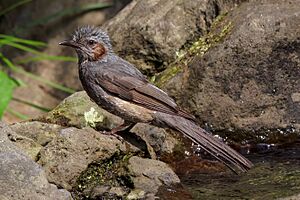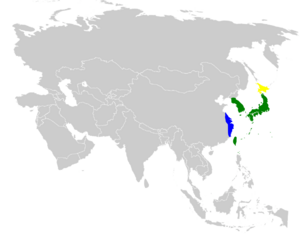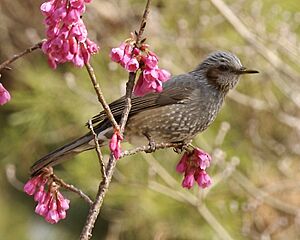Brown-eared bulbul facts for kids
Quick facts for kids Brown-eared bulbul |
|
|---|---|
 |
|
| A brown-eared bulbul in Osaka, Japan | |
| Conservation status | |
| Scientific classification | |
| Genus: |
Hypsipetes
|
| Species: |
amaurotis
|
 |
|
| Where the brown-eared bulbul lives
breeding area resident wintering area |
|
| Synonyms | |
|
|
The brown-eared bulbul (Hypsipetes amaurotis) is a medium-sized bird found in eastern Asia. It is a type of bulbul, which is a family of birds known for their loud calls. This bird is very common in the northern parts of its home range. You can find it from southern Karafuto (an island north of Japan) all the way to the northern Philippines.
Contents
About the Brown-Eared Bulbul
Scientists first described the brown-eared bulbul in 1830. Its scientific name has changed a few times over the years as scientists learn more about birds. Today, it is placed in the group Hypsipetes. People sometimes call it the Asian brown-eared bulbul or chestnut-eared bulbul.
There are different types of brown-eared bulbuls found in various places. For example, the Japanese brown-eared bulbul lives in Japan and South Korea. Another type, the Taiwan brown-eared bulbul, lives on Taiwan and nearby islands. Each type has slight differences, but they are all part of the same species.
What Does it Look Like?

Brown-eared bulbuls are about 28 centimeters (11 inches) long. They are mostly grayish-brown. They have brown patches on their cheeks, which is why they are called "brown-eared." They also have a long tail.
These birds like to live in forests. However, they can also live in cities and farms. Their loud, squeaky calls are a common sound in many parts of Japan. Some people describe their song as quite noisy!
Where Do They Live?
The brown-eared bulbul lives in a very large area. This includes the Russian Far East, northeastern China, the Korean Peninsula, and Japan. They also live south to Taiwan and the northern Philippines.
In the past, these birds would fly south for the winter. This is called migration. But now, they often stay in northern areas during winter. This is because changes in farming have given them more food options. Even so, many brown-eared bulbuls still fly south in large groups when winter comes.
Sometimes, farmers see them as pests. This is because the birds might eat crops like cabbages and spinach from orchards and fields.
How Do They Behave?
Raising Young
Female brown-eared bulbuls usually lay about five eggs. She then sits on them to keep them warm until they hatch. Interestingly, cuckoo birds sometimes lay their eggs in a bulbul's nest. When the cuckoo chick hatches, it pushes the bulbul's own eggs or chicks out of the nest!
What Do They Eat?
In the summer, brown-eared bulbuls mostly eat insects. But in the fall and winter, they switch to eating fruits and seeds. They also drink nectar from Camellia flowers. When they do this, yellow pollen gets all over them. This helps to pollinate the flowers. It's very helpful because there are not many insects around to pollinate flowers during colder months.


